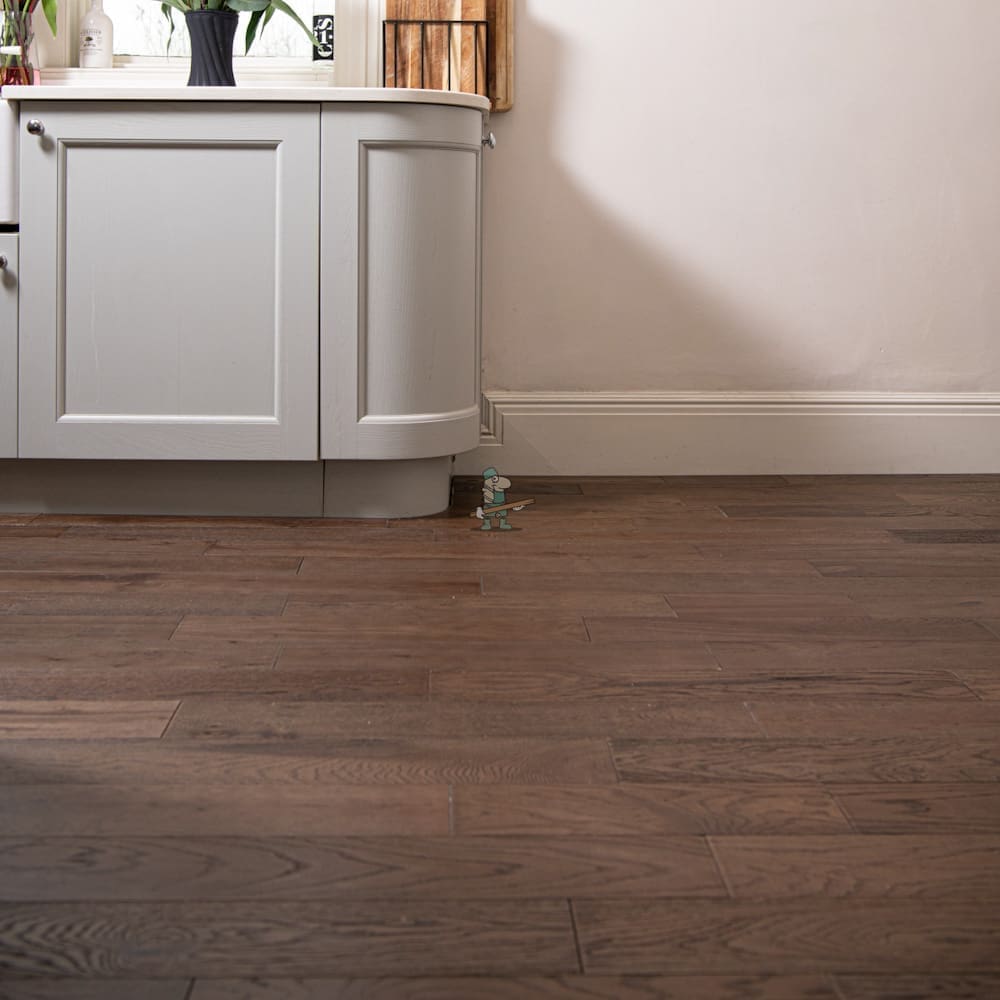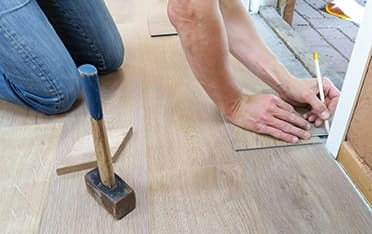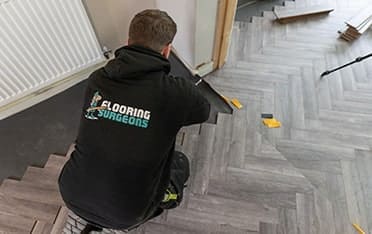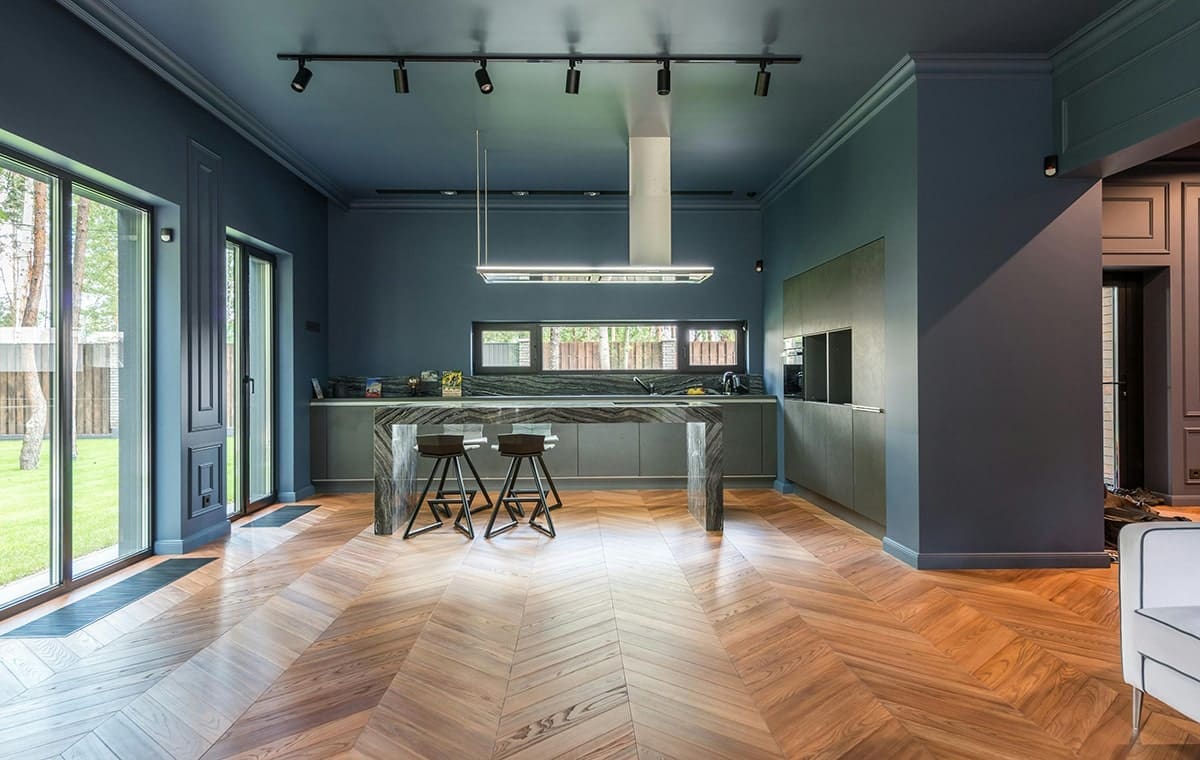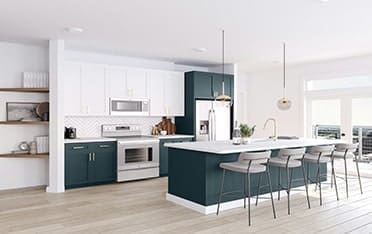This is a very common question in the flooring world; Vinyl Flooring or Laminate Flooring? Both are incredible options for your home each with their own set of benefits and drawbacks. It is important to carefully assess each category to determine which flooring is more suited to your needs.

What is Vinyl Flooring?
Vinyl flooring is a well-known flooring and although there are many types of vinyl flooring, in this particular article we will focus on LVT (Luxury Vinyl Tiles) wood look. It is composed of multiple layers of synthetic materials such as PVC and Calcium Carbonate. LVT is often chosen as flooring for bathrooms and/or kitchens due to its waterproof and easy-to-clean properties.

What is Laminate Flooring?
Laminate Flooring is a relatively inexpensive way to achieve a wood effect floor in your home and is composed of multiple layers of core wood fibres, a printed image and a protective wear layer. It is often chosen for children’s bedrooms, hallways and other areas that require a functional, easy-to-clean and relatively durable floor. The choice of models is huge, so it’s best to shop around to try and find the right model for your home.
Durability Comparison: Vinyl Flooring vs Laminate Flooring?
Both Vinyl Flooring and Laminate Flooring boast good durability with strong wear layers and high AC ratings. While neither option is anywhere near as durable as Engineered Wood Flooring and Solid Wood Flooring, they are still both fairly durable options.
Vinyl Flooring can have a core layer of PVC, WPC or SPC. They are very resistant to scratches, stains and dents
In addition to this, they normally boast incredible water-resistant properties protecting against moisture damage and spillages. This makes Vinyl Flooring a great option to add to bathrooms and kitchens.
However, Vinyl Flooring can only last up to 25 years if maintained well.
Laminate Flooring has a core layer of HDF and is resistant to everyday wear & tear as well as scratches.
However, Laminate Flooring is not as resistant to moisture as Vinyl Flooring.
Laminate Flooring will also last only 25 years if maintained well.
In conclusion, while durability of both is quite similar, Vinyl Flooring is slightly better due to its ability to protect against moisture damage.
- Vinyl Flooring has a core layer of PVC, WPC or SPC and incredible water-resistant properties but only lasts for 25 years.
- Laminate Flooring has a core layer of HDF, is resistant to everyday wear and tear but not as water-resistant and also only lasts 25 years.
Appearance & Style Options: Which one looks better?
Both Vinyl Flooring and Laminate Flooring are incredible choices aesthetically for your room. In many ways, they can be very similar both coming in a wide variety of grades and colours. While they both do look very similar, there are some notable differences such as texture and thickness which can be the deciding factor between which you choose to add to your home.
Vinyl Flooring offers a similar look to real hardwood whilst being comprised entirely of synthetic materials. While it does a good job at capturing the look of real hardwood, it doesn’t do as good of a job in terms of the feel. Its texture is quite soft and almost plastic-y. While its texture isn’t bad, it will ruin the illusion of hardwood.
Laminate Flooring also offers a similar look to real hardwood whilst being made of synthetic materials. However, Laminate Flooring is able to shine further as it offers a better, more realistic texture in comparison to Vinyl Flooring. In addition to this, Laminate Flooring is able to offer greater thicknesses. These additions help in creating a better, more authentic overall feel.
In conclusion, while both do a good job at replicating the look of real hardwood, Laminate Flooring seems to do a better job with overall feel as it has a greater texture. Additionally, it also has greater thickness options which help with the overall feel.
- Vinyl Flooring offers a similar look to hardwood but lacks on texture and thickness options.
- Laminate Flooring also offers a similar look to hardwood but has a more authentic texture and greater thickness options
Installation Process: Ease of Installing Vinyl Flooring vs Laminate Flooring
Both VInyl Flooring and Laminate Flooring are very easy to install. This is mainly due to the click-lock system which allows the planks to simply snap into place with each other. In spite of this, Vinyl might actually be slightly easier to install.
Vinyl Flooring can be installed using glue, nail down, or floating methods.
Vinyl Flooring can be easier as it requires less tools and steps thus saving you time.
Laminate Flooring can also be installed using glue, nail down, or floating methods.
Laminate Flooring can be slightly harder to install due to it requiring a hand saw as well an underlayment above the subfloor.
In conclusion, while both are very easy to install, Vinyl Flooring is slightly less time consuming due to it requiring less tools and steps.
- Vinyl Flooring uses glue, nail and floating methods and requires less tools thus saving time
- Laminate Flooring also uses glue, nail and floating methods but requires more tools and thus more time is spent installing the flooring.
Maintenance: Caring for Vinyl Flooring and Laminate Flooring
Vinyl Flooring and Laminate Flooring are equally very easy to maintain. They only require a regular sweep/vacuum as well as the occasional mop. This makes both options very low maintenance which is great for those who want flooring which isn’t too demanding to upkeep.
Cost Comparison: Vinyl Flooring vs Laminate Flooring Pricing
Vinyl Flooring and Laminate Flooring both tend to be some of the most affordable flooring options out there. While they are both very affordable, Laminate Flooring tends to be slightly more affordable.
Vinyl Flooring ranges between £20 per m2 to £39.99 per m2
Laminate Flooring is slightly more affordable ranging between £13.99 per m2 to £32.99 per m2
Environmental Impact: Sustainability of Vinyl Flooring vs Laminate Flooring
It is important to factor in the impact that our flooring can have on the environment during both the production process and when in our homes. The less environmental damage caused, the better. While both flooring types can be fairly environmentally friendly, Laminate Flooring may be slightly better for the environment.
Vinyl Flooring is 100% recyclable as it can be recycled many times without losing its performance value.
Additionally, some vinyl flooring have low carbon emissions and thus a low carbon footprint.
However, Vinyl Flooring is made from PVC which can release harmful chemicals during production and disposal.
Laminate Flooring is also recyclable and is made from recyclable materials like sawdust and wood fibers.
While it doesn’t contain any PVCs, it can emit VOCs which may affect indoor air quality.
While they are both quite environmentally sustainable, Laminate Flooring tends to be slightly better for the environment. This is mainly due to the fact that no harmful chemicals are released during production
- Vinyl Flooring is 100% recyclable and can have a low carbon footprint but is made from PVC which releases harmful chemicals during production.
- Laminate Flooring is also recyclable and doesn’t contain any PVCs but it can emit VOCs which affect indoor air quality.
Best & Worst Use Cases: Where to/Where not to Install Vinyl Flooring and Laminate Flooring
While both can be a great choice for most rooms and settings, Vinyl Flooring and Laminate Flooring have rooms where they each work better in. Additionally, they also have rooms where you should avoid putting them in to prevent damage to the floor and room.
Vinyl Flooring will look great in most rooms especially given its timeless appearance. However, due to its water-resistant properties, it is highly recommended to use Vinyl Flooring in Bathrooms and Kitchens
However, Vinyl Flooring is prone to fading from sunlight damage and so should not be used in outdoor patios or areas which may be exposed to prolonged sunlight.
Laminate Flooring also looks great in most rooms and shines in Living Rooms, Dining Rooms, and Bedrooms.
Laminate Flooring does have some water-resistant properties which means that it can be installed in the kitchen.
However, Laminate Flooring is not 100% waterproof and so should not be installed in areas which are prone to a lot of moisture such as bathrooms and basements.
- Vinyl Flooring: Best for bathrooms and kitchens. Avoid areas exposed to direct sunlight for prolonged periods of time
- Laminate Flooring: Best for Living Rooms and Dining Rooms. Avoid areas which are prone to a lot of moisture such as bathrooms.
Conclusion
In conclusion, both Vinyl Flooring and Laminate Flooring are great options to add to your home. As we have seen, every floor covering has its advantages and disadvantages. So which one is right for you depends on your personal needs and preferences. Do you need a completely waterproof floor? Do you need an easy-to-install floor? Or do you need a floor with a specific thickness? It’s important to consider your current situation, but also what factors will be critical to you 10+ years from now, as many types of flooring will last well beyond that useful life.
For any flooring queries, drop us an email at info@flooringsurgeons.co.uk – or Visit our showrooms located in Birmingham & Wolverhampton!
Explore our premium Vinyl Flooring and Laminate Flooring flooring collections today! Visit our Birmingham & Wolverhampton showrooms or shop online.
https://www.flooringsurgeons.co.uk/contact-us/
Halesowen
214A Dudley Road. Halesowen, Birmingham, B63 3NJ
0121 274 8575
Monday – Friday: 9AM – 6PM | Weekends: 10AM – 4PM
Wolverhampton
317 Penn Rd, Wolverhampton, West Midlands, WV4 5QF
01902 836666
Monday – Friday: 9AM – 6PM | Sat: 10AM – 4PM | Sun: Closed
info@flooringsurgeons.co.uk
fitting@flooringsurgeons.co.uk
customerservices@flooringsurgeons.co.uk



